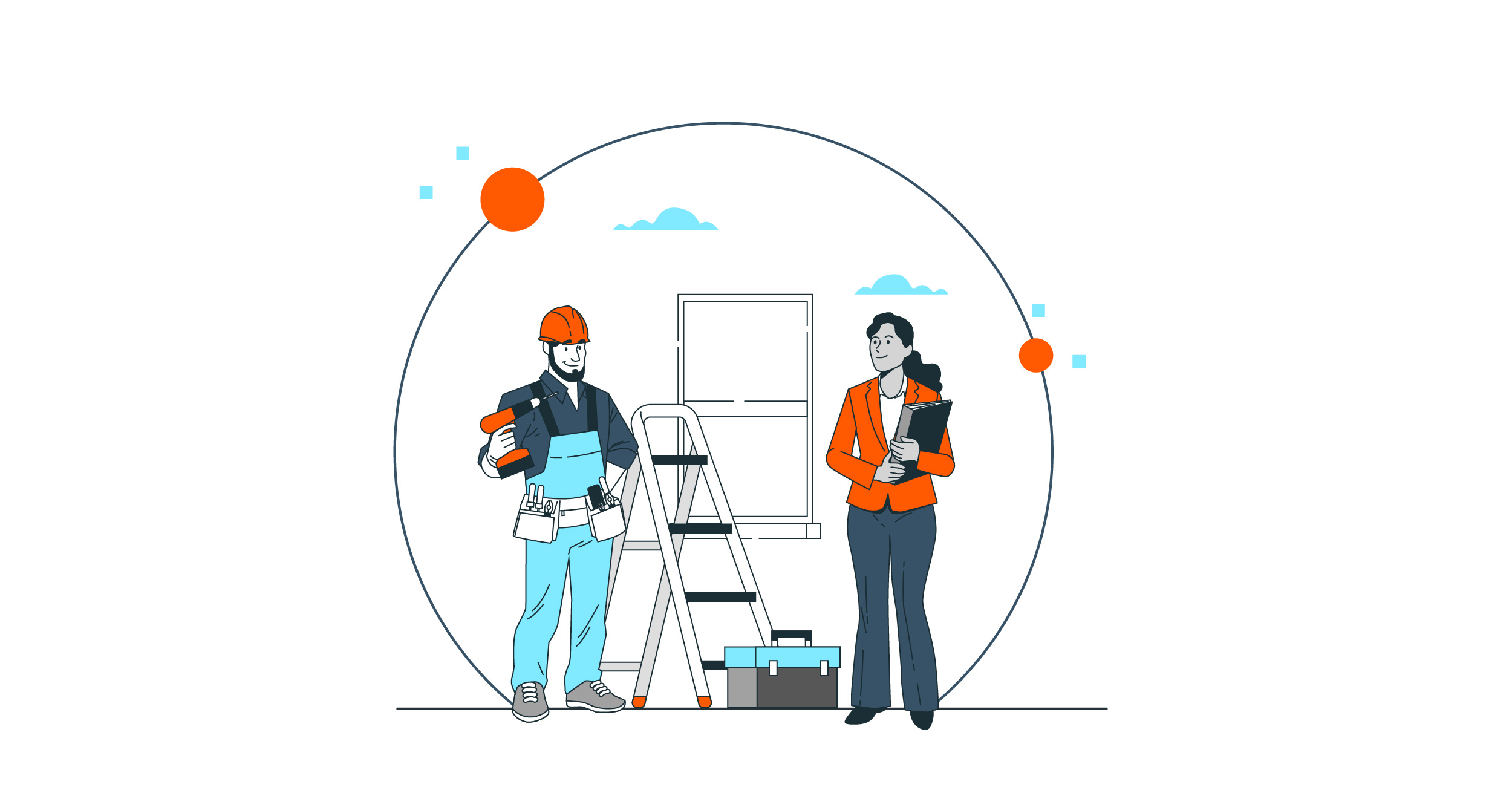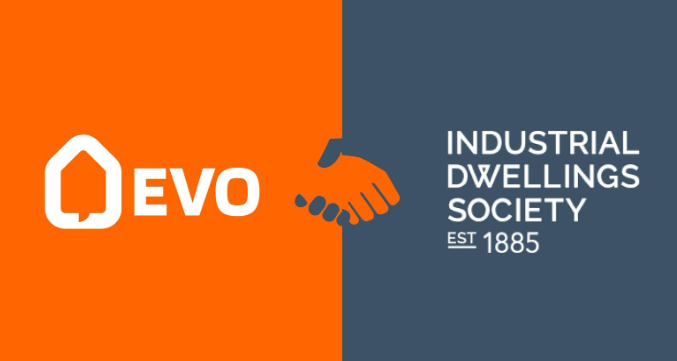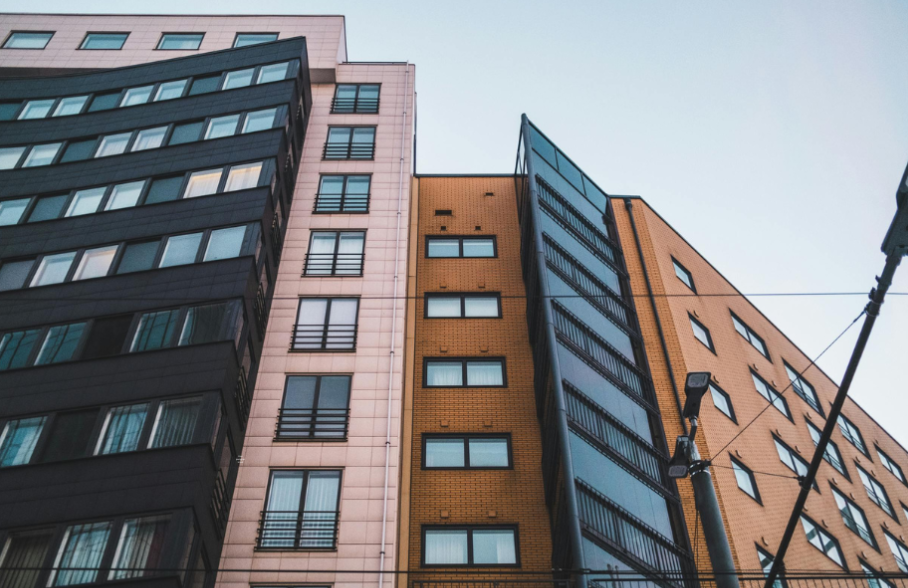
|
Key points
|
When your properties are managed effectively, your residents are more likely to have a good experience living in them.
As a result, they're more likely to stay, which means fewer empty units and lower void costs for you.
Putting your residents first also makes life easier for everyone involved in managing your rental properties.
This means fixing things promptly when they break and following the rules about housing set by the government.
Creating policies for your repairs and maintenance service is essential for meeting these responsibilities.
In this article, we cover everything you need to know about developing these policies, including what the law says and tips for setting up systems that work well.
What Are Social Housing Landlords’ Repair Obligations?
In rented property, landlords are usually responsible for all repairs and maintenance related to the building.
If one of your residents reports an issue, you need to inform them that you intend to carry out the repair and give them an expected timeline.
Repairs can be classified as:
🌞 Routine repairs: These issues are more common types of issues, but they still affect your tenants' comfort. Examples include damaged kitchen fittings, dripping tap or clogged gutters.
🌧️ Hazards: While not emergencies, these issues should be dealt with promptly. Examples include leaking roofs, broken windows, and damaged roof tiles. Landlords should investigate them within 14 calendar days of being notified by the tenant. If the hazards pose a significant risk to the residents living at the property then repair work must begin within 7 days.
⚡ Emergency repairs: These issues require immediate attention and should be fixed within 24 hours. For instance, if there's no heating in your tenant's home during extremely cold weather, or a major water leak in the property, it could impact their health.
Keeping trusted contractors on speed dial can help resolve these situations quickly.
It’s also important to keep your residents in the loop while you are arranging the repairs so they know what to expect.
|
📢 Your duty as a landlord According to the Landlord and Tenant Act, your residents rely on you to provide them with safe and secure housing. If tenants suffer harm or loss due to property issues, landlords can be held responsible and housing association tenants have the right to seek compensation. |
What Rules Do Housing Associations Have to Comply With?
Housing associations must follow several laws and regulations relating to repairs and maintenance.
Make sure you understand these rules before you draw up or amend the repair policy of a housing association:
1. Fit for human habitation
The Fit for Human Habitation Act of 2018, supersedes the Landlord and Tenant Act of 1985.
The legislation emphasises that landlords must proactively assess whether their property meets the standards for human habitation.
If it falls short, landlords are obligated to rectify the deficiencies before they can approve any rental applications.
The Fit for Human Habitation Act outlines the following requirements for homes:
-
Structural stability
-
Dampness and ventilation
-
Natural lighting
-
Water supply and drainage
-
Facilities for the preparation and cooking of food, and the disposal of wastewater
-
Sanitary conveniences, including washbasins, baths, and toilets
If your properties lack any of these, you might have to offer your tenants alternative accommodation until the issue has been resolved.
However, you are not responsible for the damage if it falls under the following categories:
🔥 Tenant-caused damage: If your tenant caused the damage themselves by acting unreasonably or failing to properly maintain the property.
🌪️ Unexpected events: Unexpected events that could not have been prevented, such as damage that occurred due to fires or storms, often referred to as an "act of God".
🚧 Blocked from action: If you are prevented from taking action by other parties, such as a third-party owner or freeholder, and you cannot address the issues.
Alongside these regulations that prioritise the safety and condition of rental properties, you also need to take the Defective Premises Act of 1972 into account.
This law kicks in when there are problems related to how residential properties are constructed, designed, or maintained.
For example, if there are issues with the building's structure, such as weak walls or faulty floors, you are responsible for addressing these issues to protect your tenants.
Simply put, the Defective Premises Act requires landlords to ensure their properties are safe and livable for tenants, addressing any hazards or defects.
2. Free from statutory nuisance
Statutory nuisance refers to environmental problems or concerns that cause harm to people who live in or frequent a certain area.
For example, if your tenant has a habit of playing loud music in the early morning hours, they may be considered a statutory nuisance in their neighbourhood.
Although this doesn’t relate directly to repairs and maintenance, addressing such nuisances is still important for maintaining a peaceful living environment for all residents.
For something to be considered a statutory nuisance, it must either:
🏠 Seriously disrupt someone's use of their home or other property
🚑 Have the potential to harm someone's health
As a social housing landlord, it’s your responsibility to take action to prevent and address any situations that could be classified as statutory nuisances within your properties.
For instance, if your tenants complain about odours or pests, you should investigate the issue, identify the source of the problem, and take measures to remedy it.
Ignoring statutory nuisances often worsens issues and requires more expensive repairs.
A woodworm infestation, for example, can lead to extensive damage to a property's structure, which can lead to spiralling costs.
3. The Decent Homes Standard
The Decent Homes Standard sets out the minimum requirements for what’s considered a “decent home” in the UK.
Introduced in 2000, this law made a big difference in social housing. It cut the number of homes that didn't meet the standard from 39% in 2001 to only 13% by 2020.
A decent social home must have adequate cooking, washing, and sanitation facilities, as well as being energy-efficient and in good repair.
Note that the Decent Homes Standard is currently under review and, as part of these discussions, the government is considering applying it to the private sector.

Source: Pexels
4. Considerate of Awaab’s Law
In 2020, tragedy struck when a toddler named Awaab Ishaak was rushed to hospital due to breathing difficulties and tragically passed away soon after.
It was later discovered that his symptoms were caused by prolonged exposure to mould in his family’s social housing home. The family had reported the hazardous living conditions three years earlier, but the landlord had failed to take the necessary action.
As a result, the social housing provider lost all its government funding and their CEO was fired.
In July 2023, Awaab’s Law was added to the Social Housing (Regulation) Act of 2023.
Under the new law, social housing landlords must:
-
Make emergency repairs within 24 hours.
-
Investigate hazards and provide a written report of your findings within 14 days of it being reported.
-
If the hazard poses a significant risk to a resident’s health or safety, you need to start repairs within 7 days,
The kinds of problems landlords need to address are listed in the Housing Health and Safety Ratings System (HHSRS).
5. Prioritise tenant health and safety
Besides meeting basic living standards, you also need to pay special attention to elements at your rental property that have their own regulations because they are regarded as high risk.
These items require regular tests to guarantee their safety. Here's a rundown of what you need to take care of:
✅ Gas safety: You must submit a gas safety certificate annually to prove that gas appliances, fittings, and flues are safe for your residents. You need to hire an engineer to inspect the safety of gas installations and appliances at your properties.
Make sure your chosen engineer is on the Gas Safe Register.
Once their assessment is completed, you will receive a gas safety certificate, which you must share with your tenants within 28 days. Learn more about gas-safe building regulations here.
✅ Electrical safety: It’s a good idea to get a qualified electrician to regularly inspect your properties’ electrical installations for potential hazards. This includes:
-
Conducting regular electrical safety inspections.
-
Identifying any potential electrical hazards.
-
Ensuring compliance with electrical regulations and standards.
-
Providing recommendations for necessary repairs or improvements.
✅ Fire safety: If you provide your residents with appliances or furniture, you must ensure these items are fire-safe.
For instance, if curtains included in your rental agreement are not fire-retardant, your tenants could be at risk.
Remember, as the landlord, you could be held liable for any resulting damages, which may involve legal consequences such as imprisonment if tenants are harmed.
You need to make sure that all furnishings provided adhere to fire safety rules under the Furniture and Furnishings (Fire Safety) Regulations, which include:
-
Each item needs to have a label from the manufacturer that can't be taken off. This label should identify the materials the item is made of.
-
All furniture has to pass two tests: the match resilience test and the cigarette test. The former checks how well the material resists burning when exposed to a lit match, while the latter assesses its resistance when in contact with a burning cigarette.
-
Mattresses and bed bases must have a label showing they meet safety standard BS7177, which is required by law.
If your property is part of a House in Multiple Occupation (HMO), fire safety is even more important because the risk of fire incidents is higher.
You might be required to install fire alarms, extinguishers, and fire doors, as well as conduct regular fire risk assessments to prepare your tenants for emergencies.
✅ Asbestos safety: Up to the 1980s, asbestos was widely used in construction due to its effectiveness and affordability in providing heat insulation. As a result, many older properties, including flats, still contain asbestos in their walls.
However, it later became evident that asbestos exposure posed significant health risks, including respiratory diseases and cancer.
As a landlord, you need to be aware of any asbestos-containing materials in your property and take measures to protect your tenants from exposure.
For example, you may need to conduct asbestos surveys, label asbestos-containing materials, and implement safe removal procedures when necessary to ensure the safety and well-being of your tenants.
Learn more by reading this guide on asbestos management for landlords.
✅ Damp and mould: As we already saw in the case of Awaab Ishaak, living in a damp and mouldy property can be life-threatening.
As a landlord, it’s your responsibility to take damp and mould issues seriously. This includes identifying the root causes of damp, such as leaks or poor ventilation, and taking immediate action to remedy them.
Find out more about your responsibilities regarding damp and mould here.
6. Ask permission to enter your property
It might be your property, but you don’t have the right to barge in unannounced or demand that your tenants let you in.
You need to give your tenants at least 24 hours written notice and they need to give you permission to enter the property.
If they decline your request, you should try to communicate with them to understand their concerns and find a mutually agreeable solution.
However, you can enter a property without permission to resolve an emergency.
Examples of this include:
⚠️ Gas leaks
⚠️ Flooding
⚠️ Fire or smoke
|
📢 Can tenants refuse to let you make repairs? Some residents may deny their landlord or tradespeople access even when it was requested within a reasonable timeframe. This is technically within their rights. However, you have the right to access your properties for urgent repairs required to meet legal obligations. While residents can deny you access, doing so might breach their tenancy agreement, allowing you to invoke the Section 8 notice. Depending on the situation, you may need to remind them of their obligations under the tenancy agreement regarding property access. If necessary, you can seek guidance from legal professionals or housing authorities, such as the council, on how to proceed. |
7. Consider residents with disabilities
Studies show that almost half (48.5%) of those living in housing association properties have a long-term illness or disability.
This means that you stand a good chance of having a resident with a disability living at one of your properties.
According to the Equality Act of 2010, you are required to make reasonable adjustments to accommodate a disabled tenant if they request it.
This includes changes that help people use the property fully, are affordable for the landlord, and remove any major disadvantages.
The interpretation of reasonable adjustment will depend on you and your tenant, but it’s your responsibility to prioritise looking into such a request since it has a big impact on your resident's life.
Read our article explaining how you can upgrade your kitchen and bathroom to accommodate a resident with a disability.

Source: Pexels
8. Ensure tenants understand your systems
According to the Charter for Housing Association Applicants and Residents, you need to make sure your tenants know how the systems and processes work within your repair and maintenance policy.
Within your policy itself, you must include:
📜 Clear deadlines for different types of repairs, like emergencies, urgent issues, and regular maintenance tasks.
📜 Instructions on how to respond to common repair concerns, such as turning off the water supply to prevent further damage and notifying you immediately.
📜 A summary of how you will deal with these emergencies. For example, you might provide temporary accommodation if their property becomes uninhabitable.
📜 A guide on what they should do if you don’t live up to your commitments in the maintenance and repair policy, such as providing a clear procedure for lodging complaints.
Your repairs policy will prevent disputes and confusion by clearly outlining responsibilities and processes if anything goes wrong at your properties.
9. Collect Tenant Satisfaction Measures data
You are also responsible for checking in with residents and ensuring they’re satisfied with your service.
According to the Regulator for Social Housing, you must collect Tenant Satisfaction Measures (or TSMs) that show how successful your maintenance and repairs have been.
These surveys can take place over the phone, online, or face-to-face.
If you own less than 1,000 properties, then you only need to collect TSMs once every two years. If you own more, then you are required to do this annually.
Have a look at the tables in this article to see the correct wording you should use in your surveys.
|
📢 The importance of planned preventative maintenance Planned Preventative Maintenance (PPM) is when you schedule regular check-ups and services to stop things from breaking and keep everything running smoothly. Although you are not legally required to do PPM, addressing small issues early on can save you a lot of time and money in the long run. Find out why PPM is so important for home associations here. |
What Repairs Are Social Housing Landlords Responsible For?
When a tenant reaches out to you about a repair or maintenance issue, you may find yourself wondering whether they caused the issue or whether you are at fault.
🚽 Did your tenant cause the clogged drains, or are the leaking pipes a result of underlying infrastructure issues that you should have addressed?
🔌 Was the electrical failure caused by tenant negligence or is there an issue with the property’s electrical circuit?
🐜 Did the pest infestation occur due to a lack of cleanliness on the tenant's part, or are there structural vulnerabilities in the property?
To simplify matters, landlords are responsible for repairs related to the building itself, while residents are responsible for their own belongings, any damage they cause, and reporting problems with the building.
Here are some examples of the kinds of issues you are responsible for:
Inside the residence
🔨 Repairing roofs, chimneys, gutters, and drains
🔨 Clearing obstructions in drains (unless caused by blocked grates)
🔨 Keeping shared spaces clean and tidy
🔨 Structural issues with walls, paths, external doors, and windows (excluding glass)
🔨 Installing new rotary clotheslines
🔨 Applying fresh paint to the exterior of houses every seven years
🔨 Clearing clogged sewers
🔨 Maintaining fences or gates the landlord installed
Outside the residence
🔧 Ensuring roof insulation is properly maintained
🔧 Repairing skirting boards and window sills
🔧 Fixing internal doors and their frames
🔧 Installing new tiles if they were originally provided by the landlord
🔧 Repairing structural wooden elements and addressing any rot issues
🔧 Replacing waste bins as needed, usually every seven years
On top of this, you need to consider any additional repairs that relate to health and safety issues, such as damaged electrical wiring or faulty radiators.
Residents, on the other hand, are responsible for issues such as:
Inside the residence
🔨 Patching internal plaster cracks
🔨 Interior decorating tasks
🔨 Replacing washers, plugs, and stoppers
🔨 Taking draught-proofing measures
🔨 Fixing hinges, locks, and handles on internal doors
Outside the residence
🔧 Clearing out drains, gully traps, and gratings
🔧 Repairing or replacing broken window panes
🔧 Tending to garden maintenance and landscaping
The tenancy agreement you have with your resident should outline exactly who is responsible for what. It should be used as a guide when determining who should take responsibility.
|
📢 Can residents make their own home improvements? The extent of changes that a housing association resident can make depends on the agreement you have with them. Typically, those with starter leases can only do minor things like painting their interior walls. Those with secure leases have more freedom, but they might still require permission from the council. |
How to Effectively Manage Repairs and Maintenance
You need to ensure your repairs and maintenance system is practical and effective.
Nowadays, there are digital tools available to help you do this.
These include specialist software, mobile apps, and online platforms designed to streamline the process and improve communication between landlords, tenants, and maintenance staff.
For example, EVO is an end-to-end digital solution that landlords can use to outsource their repair and maintenance jobs.
This is how you successfully implement repairs with the aid of the latest technology:
1. Make it easy for residents to report issues
Many social housing providers continue to use traditional communication methods like phone calls, self serve web portals and letters to engage with residents regarding repair issues.
However, there's several generations that rarely uses a landline or writes letters by hand. This means your communication methods might not resonate with them.
On top of this, these old-school methods are less efficient. For example, if a tenant calls you to report an issue, they may be kept on hold for an hour waiting to speak to your team.
This makes them frustrated and dissuades them from contacting you in future.
Nowadays, everything happens on your mobile phone, which is why it’s important to connect with your tenants there.
For instance, with the EVO Residents app, residents can take photos and videos of their repair and maintenance issues and submit them with their repair requests. This provides you and the tradesperson in question with a clear picture of each individual situation.
This app not only streamlines the process, but also allows residents to resume their daily activities instead of spending hours on the phone.

Source: Pexels
2. Automate job allocation
There are two main issues with finding the right tradesperson to handle your particular repair or maintenance needs:
⏳ Time-consuming process: Researching, contacting, and booking different tradespeople can take a lot of time, especially if your preferred tradespeople are unavailable.
💪 Uncertainty about effectiveness: Even after you have selected a tradesperson, there may be doubts about their skills and ability to effectively address the repair issue.
EVO sends repair jobs straight to the next available tradesperson and, once accepted, your resident will receive three time slots to choose from.
You also won't have to worry about the qualifications of the tradespeople, as all those whom you connect with through EVO have already been vetted and approved.
3. Have a system for accessing properties
If your residents are not available to let tradespeople into their homes, this could delay the whole process and allow issues to get even worse.
Social home providers often have designated key holders who ensure access to properties when residents are unavailable.
However, this may not always guarantee immediate access, especially if they are unavailable or unreachable during emergencies.
EVO provides a secure key exchange service.
Residents can drop off their keys at a secure, verified location where the trusted tradesperson will collect them in order to access the property, get the job done, and return the keys.
Get Started with EVO Today
Having a thorough repairs policy in place is important because it makes sure that problems get fixed quickly and ensures that you comply with regulations.
Using EVO alongside your maintenance and repair policy will transform the way you deliver solutions by automating the process and enabling better communication.
This increases efficiency, makes residents happier, and reduces time and resource requirements.
If you would like to learn more, get in touch with us today.d
PHOTO BY EVO


